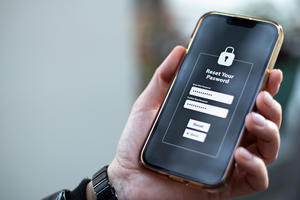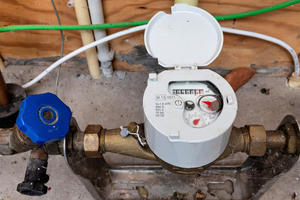Whether you’re a school or college that closes for the holidays or a seasonal business open in summer or winter, there’s a lot to sort out when you’re thinking about closing and reopening your business. It can be helpful to have your own checklist to follow each time so here’s a quick guide to safely managing your water supply.
What to do before you temporarily close
Turn off your stopcock
If your stopcock is not turned off, you may have water flowing through your meter while your premises is empty - this is chargeable water use that will appear on your bill. If you decide to leave it on, check that you or others know where to access it in case of an emergency i.e. a burst pipe or leak.
Send us a meter read
Giving us a meter read before you temporarily close means that your bill will be based on actual use and will be more accurate. Our billing system works by estimating your use based on past meter readings, so if we don’t have a recent read (either from you or a meter reader), this could mean your next bill is higher than it needs to be. You can quickly and easily submit a meter reading online.
By sending your own reads frequently, your charges will be more accurate based on your actual water use, which may be less than usual if you’re temporarily closing your doors.
Check for potential water leaks
If you need to maintain a water supply to your premises (for certain appliances for example), check for any obvious issues that could lead to water leaks such as dripping taps and trickling toilets. Pipes are more at risk of freezing in the winter if you have a dripping tap but you can usually fix the issue by changing the washer.
The last thing you need during a period of closure is an unexpected water leak causing damage to your property, so it’s worth checking it regularly during temporary closure, providing it’s safe and you’re able to.
Check your pipes, drains and gutters
Now’s the time to consider lagging pipes, particularly if your water supply will be maintained while your business is temporarily closed.
Loose leaves and wet weather can also contribute to rubbish and debris blocking gutters and drains, stopping water flowing. If water has nowhere else to go it can build up and leak into roofs and walls or it may freeze and damage your property.
Make sure your water supply is safe before your business reopens
After a period of closure, you need to prepare your water supply or safe use again. Even if your water has not been officially disconnected, there are a few things you need to do to make sure your water supply is safe for you, your staff and your customers to use once you’re back in business.
Any water that’s been stuck in pipework connected to fixtures like sinks, showers and water coolers, or water that’s been sat in toilet cisterns and toilet bowls, will now be potentially stagnant. This can be a breeding ground for harmful bacteria.
So, to make sure every part of your water system is clear of any nasty germs, smells or impurities, you need to ‘flush out’ and clean everything before use, ideally 24 hours before reopening.
If possible, anybody flushing and cleaning should wear some sort of protective wear – like latex gloves and a facemask. This isn’t because you might catch coronavirus from your water supply, but because of other potential health risks (such as the spread of airborne Legionella).
Getting your water supply up and running
Taps
- Find out where your water enters your premises (usually where the stopcock is) and turn on the nearest tap to that point.
- Systematically turn on the next nearest tap, then the next, and so on, until all your taps are running.
- Keep them running until the cold water supply is clear and cool, and the hot water supply is clear and hot (if in any doubt, run all the taps for ten minutes).
- If your tap water is supplied from an internal storage tank, you need to empty the tank first, refill it from your external water source, and then run the taps as described above.
Toilets
- Flush all toilets (and any urinals) twice to circulate fresh water and empty the cistern.
Showers
- First, make sure there's plenty of ventilation (e.g. if in a shower cubicle make sure the door stays open).
- Remove any shower heads before running water through the shower itself.
- Run the shower on full blast, at the lowest temperature, for ten minutes.
Refillable water coolers
- Refillable water coolers should be cleaned regularly according to the manufacturer’s instructions
- If you’re responsible for the water cooler but can't access the cleaning instructions, there are step-by-step guides on how to do this online.
- It’s advisable to use disinfecting products that are approved for use in water coolers, rather than any DIY versions.
- Whatever level of cleaning you’re able to do, you should drain your existing water refill through the dispenser tap before replacing it with a new, sealed barrel.
- Also clean out any drip trays and wipe dispensing taps with a mild disinfectant before using again.
Appliances which draw directly on the water supply (e.g. plumbed-in coffee machines, beverage machines, plumbed-in water dispensers)
- If you’re responsible for cleaning appliances which draw directly on your water supply, you should check the manufacturer’s instruction manual (many are now online) and look up the sections on ‘flushing’ or ‘cleaning’ and follow the recommended cleaning procedures.
- However, if you’re unsure about the correct way to clean your appliances, speak to your original supplier if possible, or a third-party cleaning specialist for advice.
- If in doubt, we recommend you take any appliances out of use until they can be cleaned with confidence.
Kettles, coffee makers and filtration jugs
- Empty any kettles, wash them, refill with fresh water and boil a couple of times, then empty them again before first use.
- If you have a coffee maker which has its own tank, wash out the tank thoroughly.
- Clean any drip-trays, jugs, filters, nozzles and any other part of the machine which are designed to be removed for cleaning - ideally by following the manufacturer’s instructions.
- Once the machine is cleaned and reassembled, run it a couple of times without any coffee to make sure the water comes out clear.
- If you have any water filter jugs, empty any water and replace (or clean) the filter.
- Also empty and clean any ice-machines, including those built into fridges.
Water filters and softeners
- If your property has any internal filters or water softeners, check these to make sure they’re working as per the manufacturer’s instruction manual.
For larger buildings and/or properties with complex pipework and extensive plumbing systems
- If your premises has extensive and/or complex plumbing infrastructure, it's a good idea to get it checked by a reputable professional if you can – such as a plumber who is part of the WaterSafe scheme – before you re-open.
- As well as the flushing and cleaning advised in this guide, you may want to consider arranging more comprehensive cleaning and disinfecting treatments. If this is the case, make sure someone qualified does the work.
- Recommissioning your water supply should also be in-line with your water safety management plan, including pressure testing all your systems.
- Professional ‘confirmatory testing’ is also widely available for water systems (but there would be a cost).
Still unsure? Get in touch
If you’re not sure about any of these recommended steps, you can talk to us and we'll do our best to help.
If we can’t help you directly, we’ll put you in touch with a specialist who can.
The best way to contact us is usually via web chat but you can also call our team or send us an email. We’re here to help and support you however we can.
For more guidance about preparing your water supply for reopening, you can also visit Water UK or Drinking Water Inspectorate.


